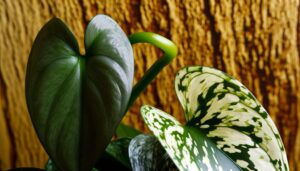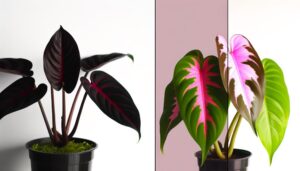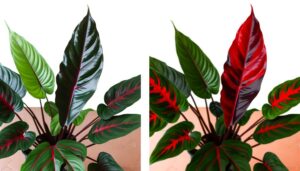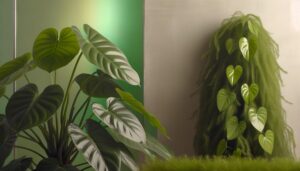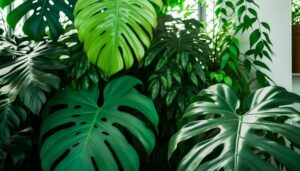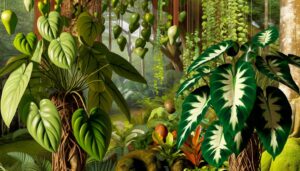Philodendron Gloriosum Vs Splendid: Which is Right for You?
Philodendron Gloriosum and Philodendron Splendid are distinct members of the Araceae family, both originating from tropical rainforests in South and Central America. Gloriosum features large, cordate leaves with velvety textures and pronounced veins, ideal for capturing light and water runoff.
In contrast, Splendid exhibits elongated, ovate leaves with a glossy, leathery finish and less pronounced venation, enhancing its aesthetic qualities. Gloriosum’s creeping growth habit enables leaf sizes up to 36 inches, while the upright, compact Splendid achieves up to 24 inches.
Both require bright, indirect light, high humidity, and well-draining soil. Discover more intricate details about these remarkable species.
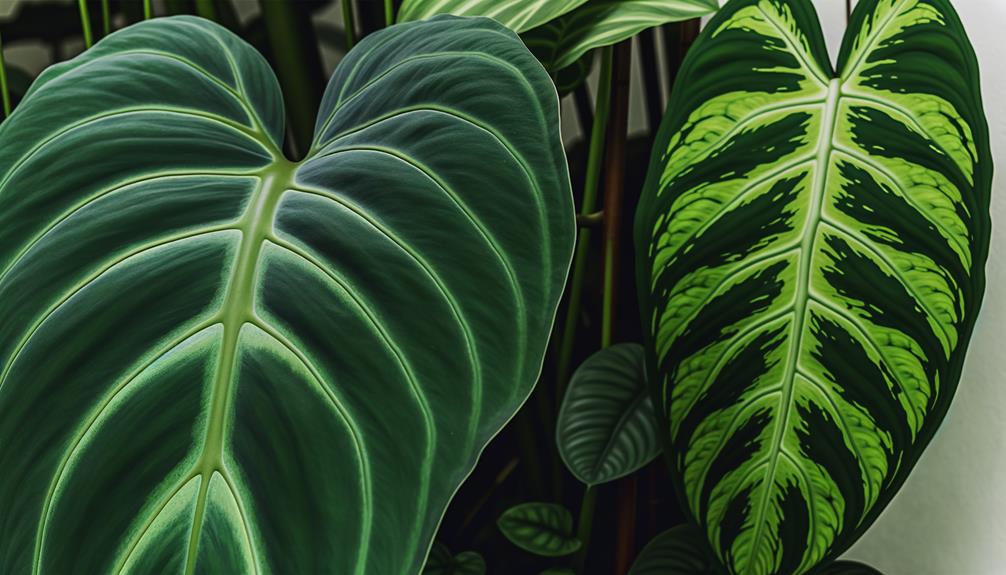
Comparison of Philodendron Gloriosum and Philodendron Splendid
| Feature | Philodendron Gloriosum | Philodendron Splendid |
|---|---|---|
| Leaf Shape | Heart-shaped, rounder | Heart-shaped, more elongated |
| Leaf Size | Can reach up to 90 cm | Generally smaller than Gloriosum |
| Leaf Color | Bright green with prominent white veins | Dark green with light veins |
| Leaf Texture | Velvety | Velvety |
| Growth Habit | Terrestrial, crawling | Climbing |
| Petiole Shape | D-shaped (typically) | Round |
| Origin | Natural species | Hybrid (P. verrucosum x P. melanochrysum) |
| Rarity | Rare in nature, more common in cultivation | Relatively rare |
Origin and Natural Habitat
Philodendron Gloriosum and Philodendron Splendid, both members of the Araceae family, originate from the tropical rainforests of South and Central America, where they thrive in the understory’s humid and shaded conditions.
These epiphytic or hemiepiphytic plants are adapted to low-light environments, relying on the dappled sunlight that filters through the dense forest canopy. Their natural habitat is characterized by consistently high humidity levels, warm temperatures, and nutrient-rich, well-draining soil composed of decomposed organic matter.
These conditions facilitate their vigorous growth and enable their extensive root systems to absorb moisture and nutrients efficiently. The microclimate of the rainforest understory ensures the stable environmental parameters necessary for their best physiological functioning and developmental processes, contributing to their lush, verdant foliage.
Leaf Shape and Texture
The morphological differences between Philodendron Gloriosum and Philodendron Splendid become particularly evident when examining their leaf shape and texture. These traits are pivotal and influenced by their adaptation to the rainforest understory.
Philodendron Gloriosum exhibits cordate (heart-shaped) leaves with a velvety texture and deeply pronounced veins. These features aid in efficient light capture and water runoff.
Conversely, Philodendron Splendid, a hybrid of P. verrucosum and P. melanochrysum, features elongated, ovate leaves with a leathery texture. The leaves of P. Splendid possess a glossy finish and less pronounced venation, contributing to their distinctive aesthetic and functional properties.
These differences in leaf morphology are key adaptations that facilitate their survival and ecological niches within the dense, shaded rainforest environment.
Growth and Size
Often displaying remarkable growth patterns, both Philodendron Gloriosum and Philodendron Splendid demonstrate distinct variations in size and developmental habits that reflect their unique genetic and environmental adaptations.
Philodendron Gloriosum, characterized by its creeping growth habit, often expands horizontally, forming a sprawling network of foliage. This species can achieve leaf sizes up to 36 inches in length under ideal conditions.
In contrast, Philodendron Splendid, a hybrid of P. verrucosum and P. melanochrysum, exhibits a more upright growth pattern. This results in a more compact structure, with individual leaves reaching up to 24 inches.
The varied growth habits and sizes of these philodendrons highlight their evolutionary responses to different ecological niches, underscoring the diversity within the Araceae family.
Care Requirements
Supporting peak care for Philodendron Gloriosum and Philodendron Splendid necessitates a comprehensive understanding of their specific light, water, and soil requirements. Both species thrive in bright, indirect light, which mirrors their natural understory habitat. Direct sunlight can lead to leaf scorch, compromising their vibrant foliage.
Ideal watering involves maintaining consistently moist, but not waterlogged, soil; overwatering risks root rot, while under-watering causes desiccation. Using well-draining, aerated soil with organic matter supports root health. Humidity levels of 60-80% are ideal, preventing leaf browning and promoting lush growth.
Temperature ranges between 65-80°F (18-27°C) are preferred, avoiding drafts and extreme fluctuations. Following these precise care parameters supports the robust health and longevity of both Philodendron species.
Aesthetic and Design Appeal
Philodendron Gloriosum’s velvety, heart-shaped leaves with pronounced white veins, contrasted against Philodendron Splendid’s elongated, deep green foliage with intricate light green patterns, offer distinct yet equally alluring aesthetic qualities that elevate interior design.
Both species’ unique morphological characteristics contribute to their decorative appeal. The Gloriosum’s broad leaves introduce a lush, tropical ambiance, while the Splendid’s elongated leaves offer a more streamlined, contemporary look.
These attributes can be summarized as:
- Leaf Morphology: Gloriosum’s ovate, velutinous leaves versus Splendid’s lanceolate, coriaceous foliage.
- Vein Patterning: Prominent white veining in Gloriosum versus subtle, reticulated green veins in Splendid.
- Design Versatility: Gloriosum for tropical themes; Splendid for modern, minimalist spaces.
This detailed comparison aids in selecting the ideal plant for specific interior design needs.
Conclusion
In summation, Philodendron gloriosum and Philodendron splendid, each with distinct botanical characteristics and care requirements, evoke the duality found in the natural world’s grand design.
Their unique leaf morphologies and growth patterns cater to varied aesthetic preferences and environmental conditions. Understanding these differences enables informed cultivation, reminiscent of a horticulturist’s nuanced approach to biodiversity.
Therefore, these species exemplify the diverse beauty and complexity inherent in the world of tropical flora.

